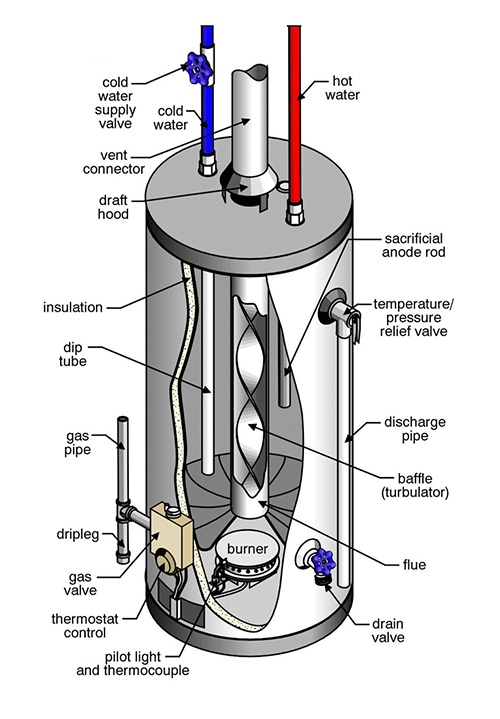Your gas-powered water heater is probably not at the top of your list of homeowner concerns. For most of us, water heaters seem to work fine, until they don’t. And, when they fail, oftentimes the result is an extended period of cold-water showers followed by a costly replacement. But, what if you could avoid that surprise repair bill by adopting a simple, easy maintenance routine?
Common Water Heater Issues You Can Avoid with Regular Maintenance
Water Leaks
No Hot Water
Foul Odor
Lime Scale Buildup
Corrosion
Low Water Pressure
Overheating
Key Components of a Gas Water Heater
First, let’s take a look at the main working parts of a water heater, from top to bottom.

Cold Water Supply Valve
This valve controls the flow of cold water into the water heater for heating.
Cold Water/Hot Water Pipes
Water enters the water heater through the cold water pipe and leaves through the hot water pipe.
Draft Hood and Vent Connector
The vent connector is used to exhaust fumes called flue gasses, which may contain carbon monoxide. The draft hood directs flue gasses to the vent connector. It also reduces the size of the opening in the water heater to accommodate the vent pipe.
Anode Rod
This device absorbs corrosive material inside the tank to reduce tank corrosion. A sewer gas smell may indicate that the anode rod needs to be changed.
Insulation
Most gas water heaters are insulated to help the heated water stay hot. In some cases, the insulation is on the outside of the tank.
Temperature & Pressure Relief Valve and Discharge Pipe
When the water temperature and pressure level get too high, the T&P automatically opens to reduce internal tank pressure. The discharge pipe provides an outlet for the pressure from the T&P relief valve. In Illinois, the bottom end of the discharge pipe must be within 6 inches of the floor. The pipe must also be made from approved material. It should also be 3/4″ ID. Check with local authorities having jurisdiction to learn what types of materials and diameter are required in your area.
Dip Tube
The dip tube guides cold water entering the tank to the bottom of the water heater where it’s heated by the burner.
Baffle and Flue
The flue houses the baffle or turbulator. The baffle leads flue gasses from the tank up to the draft hood for exhausting through the vent connector.
Gas Pipe, Drip Leg (better known as a sediment trap) and Gas Valve
The gas pipe brings the gas needed to run the burner. The gas valve is used to shut off the supply of gas to the burner. The sediment trap is designed to catch moisture and debris that may get into the gas valve. This moisture and debris can cause the control valve to malfunction.
Thermostat and Burner
The thermostat monitors the temperature of the water and ignites the burner when the temperature drops below the level you set.
Pilot Light and Thermocouple
The pilot light is what ignites the gas burner when the thermostat triggers it. The thermocouple opens and closes the gas valve as required to supply the pilot light. Many newer water heaters have an ignition switch in place of the pilot light and thermocouple.
Drain Valve
Drain valves are used to empty the water heater for maintenance or when you need to replace it.
How to Maintain Your Gas Water Heater
Preventative maintenance is key to keeping your water heater running smoothly. With proper care, a good quality water heater can last as long as 12 years! While most of these tasks are easy to complete on your own, it’s always a good idea to hire a professional if you’re at all uncomfortable with any of them.
Gas Water Heater Maintenance Checklist
Weekly Water Heater Maintenance Tasks
This weekly inspection should take just a few minutes – a worthwhile investment! If you observe anything out of the ordinary, enlist the help of a professional to assess the extent of the problem.
- Visual Inspection
Check the heater and the area around it for any sign of water leaks. Also, check for unusual odors coming from the water heater. When you smell something similar to sewer gas, your anode rod may need to be replaced. If you’re not sure, call a qualified plumbing professional. - Check the Pilot Light
If your water heater has a pilot light, check it to make sure it’s burning steadily with a blue flame. - Inspect Vents and Flue
Visually examine the water heater air intake (at the bottom of the water hear), the flue, and vents for debris, spider webs or any other kind of blockage.
Monthly Water Heater Maintenance Tasks
Once a month, add these points to your weekly inspection. This small additional investment will help your water heater run at its best and keep your energy costs down. As always, if you see anything out of the ordinary, call a professional.
- Check the Pressure Relief Valve
Using a bucket to catch the water, open the relief valve for a few seconds to verify it’s working. Your water heater manufacturer may recommend a different frequency or method for checking the valve. - Flush a Pint of Water
Locate the water heater discharge pipe and place a bucket below it. Open the drain valve and let the water flow until you’ve collected a pint. By doing this, you’ll flush out a good portion of the sediment that’s built up over the past month. Again, your water heater manufacturer may recommend an different frequency for flushing the heater. - Check for Unusual Noises
Once the water heater has been heating up for a while, listen for popping or any other unexpected sounds. You may hear a sound similar to an old-fashioned coffee percolator. This could indicate excessive sediment buildup in the tank. Sediment buildup is the number one reason for water heater leaks and failures. - Monitor Water Temperature
Turn on the hot water in the faucet nearest the water heater. Check the temperature of the flowing water (a meat thermometer is a good tool to use) to make sure it’s around 120 degrees F. Anything above 120 degrees can cause burns.
Annual Water Heater Maintenance Tasks
Adding these tasks to your monthly water heater checklist once a year will prolong the life of your device significantly. Before you start any of these projects, turn off the water heater and the gas leading to it. Some of these tasks require skills or tools that are beyond the scope of a typical homeowner. If you are not comfortable completing any of these tasks yourself, please call a professional.
- Drain and Flush the Tank
Place a bucket beneath the discharge pipe. Open the drain valve and completely empty the tank. Keep the valve open and flush the tank to remove excess sediment and reduce corrosion. - Test the Temperature & Pressure Relief Valve
Open the valve by lifting the lever up and down several times, then leave it open for five seconds. A small amount of water should flow into the drain tube. Your water heater’s manufacturer may recommend a different method or frequency. - Check the Anode Rod
Inspect the anode rod for excessive corrosion. If there is a lot of corrosion on the rod, replace it to prevent corrosion in the tank itself. One indicator that it’s time to replace the anode rod is a sewer gas smell in the area of the water heater. If you’re not sure how to proceed, call a qualified plumbing professional. - Tighten Electrical Connections
If your water heater is power-vented, verify that all electrical connections are secure. Tighten any that are loose. Check all wiring for signs of wear or damage.
When You should Call a Professional
When you perform your weekly, monthly and annual water heater maintenance tasks, you may notice some symptoms that are out of the ordinary. That’s when it’s time to call a qualified plumbing professional. Here are a some, but not all of the signs it’s time to call for help.
Nine Signs You Should Call a Professional to Service Your Gas Water Heater
- You have ongoing water leaks.
- There is no hot water or overly hot water.
- Unusual sounds are coming from the water heater.
- The pilot light won’t stay lit.
- Corrosion
- You notice foul odors in the area of the water heater.
- There is excessive accumulation of sediment.
- You notice signs of corrosion on the outside of the water heater.
Setting and following a regular maintenance schedule is the key to prolonging the life of your gas-powered water heater. Not only will you avoid costly repairs or replacements, you’ll also avoid the surprise cold shower!
